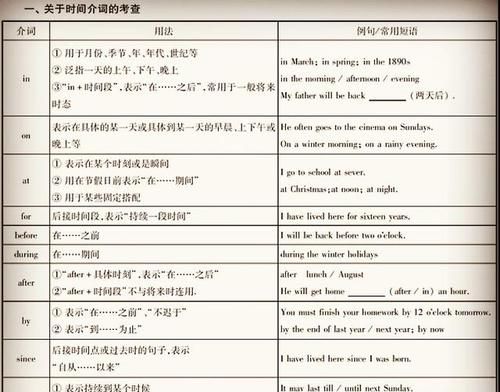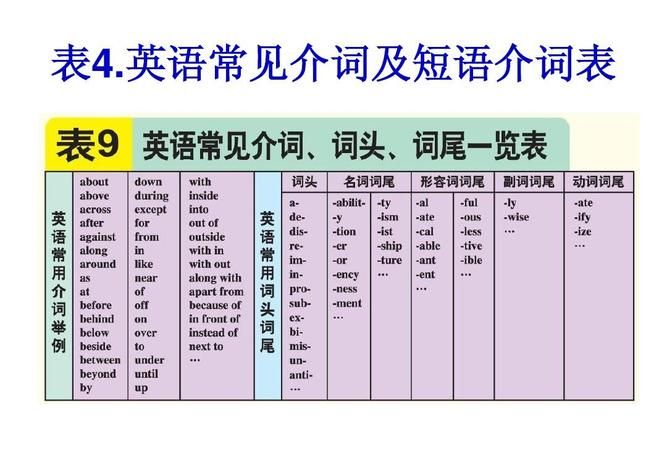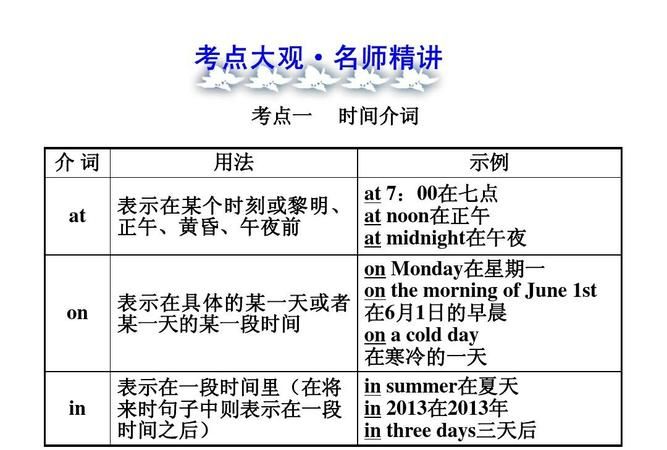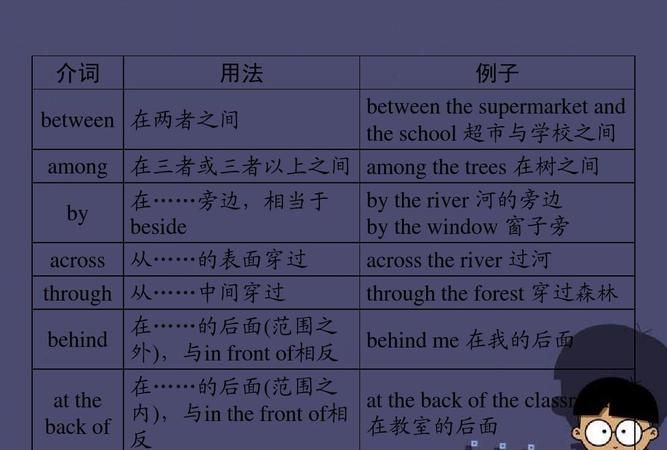本文目录
中考英语知识点:表示地点、方位的介词
介词短语,是介词和其它代词或名词或词组搭配形成的短语。口语上简称“介短”。该短语主要是用来表示词与词, 词与句之间的关系。下面我分享一下介词短语的相关信息。
介词短语简介
介词又称作前置词,表示名词、代词等与句中其它词的关系,在句中不能单独作句子成分。介词后面一般有名词、代词或相当于名词的其他词类、短语或从句作它的宾语,表示与其他成分的关系。
介词和它的宾语构成介词词组,在句中作状语,表语,补语,定语或介词宾语。同时介词的用法也很灵活,同一个介词可以表达多种意义,介词可以分为时间介词、地点介词、方式介词、原因介词、数量介词和其他介词。
介词短语,是介词和其它代词或名词或词组搭配形成的短语。口语上简称“介短”。该短语主要是用来表示词与词, 词与句之间的关系。
介词短语:介词和不同的词搭配
(一)介词和名词搭配
in time及时 on time准时,按时 at home在家
by the way顺便说说 by hand用手 亲手
(二)介词和动词搭配
look at看 look for寻找 call on号召 访问
put up穿上 go on继续 pass on 传递
(三)介词和形容词、过去分词搭配
be kind to对某人好 take care of照顾 关心
be born in出生于…… be made of由……制成
中考常见的介词短语
by accident 偶然 in addition 另外 on account of 因为,由于
on account of 因为,由于 in case 假如,以防 ( 万一 ) 免得
by chance 偶然,碰巧 in charge (of) 负责,主管 in no case 决不
above all 尤其是,最重要的是 after all 毕竟,到底
in common 共用,共有,共同 in conclusion 最后,总之
in conclusion 最后,总之 in the course of 在 …… 过程中,在 …… 期间
of course 当然,自然,无疑 in danger 在危险中,垂危
up to date 时新的 in difficulties 处境困难 in the distance 在远处
for example 例如 in force 有效;实施中 in the past 在过去,以往

初中英语介词知识点总结
对于大多数 英语学习 者来说,在英语的学习过程中,介词无疑是一大难点。虽然介词的数量不多,但介词是英语语言中最为活跃的词汇。下面是我为大家整理的初中英语介词知识点,欢迎大家阅读学习!
目录初中英语介词知识点
常用的五种介词短语
初中英语学习方法
初中英语介词知识点表示时间的介词:
(1)in,on,at 在……时
in表较长时间,世纪朝代时代、年、季节、月及一般(非特指)的早、中、晚
如:in the 20th century,in the 1950s,in 1989,in summer,in January,in the morning,in the night,in one's life ,in one's thirties
on表示具体某一天及某一天的早、中、晚。
如:on May 1st,on Monday,on New Year's Day,on a cold night ,in January,on a fine morning,on Sunday afternoon.
at表示某一时刻或较短暂的时间,或泛指 圣诞节 ,复活节等。
如:at 3:20,at this time of year,at the beginning of,at the end of …,at the age of …,at Christmas,at night,at noon,at this moment
在last,next,this,that,some,every 等词之前一律不用介词
如:We meet every day.
(2)in,after 在……之后
“in +段时间”表示将来的一段时间以后;
“after+段时间”表示过去的一段时间以后;
“after+将来点时间”表示将来的某一时刻以后。
例句:My mother will come back in three or four days.
He arrived after five months.
She will appear after five o'clock this afternoon.
(3)from,since 自从……
from仅说明什么时候开始,不说明某动作或情况持续多久;
since表示某动作或情况持续至说话时刻,通常与完成时连用。
例句:He studied the piano from the age of three.
They have lived here since 1978.
(4)after,behind 在……之后
after主要用于表示时间;
behind主要用于表示位置。
例句:We shall leave after lunch.
Lucy is hiding behind an old house.
初中英语介词知识点:五种介词 短语
英语介词不可单独使用,只能与不同的此类构成介词短语来在 句子 中担当一个成分。
1.介词+名词:at the door,into the bag
2.介词+代词:for me,of others
3.介词+动名词:in doing so,to my saying that
4.介词+连接副词/连接代词/what从句:over what he had better do
5.介词+连接副词/连接代词+不定式:on how to do this
其他类型的介词短语
6.介词+介词短语:from across the street, until after dinner
7.介词+副词:from below
8.介词+复合结构:with the light on
9.介词+不定式(but/except):…did nothing but sleep介词、连接词与词纽带
英语经常用介词来表示词与词之间的关系
1、初中英语学习方法之多积累
初中英语学习最好用的方法就是英语 文章 要多背,背诵英语文章对学生的英语学习非常有益。背诵文章不仅能学到更多的单词,而且还能掌握大量的语法知识。背诵文章将为学生今后的 英语写作 打下良好的基础。在背诵开始时,你可以选择一些简单而又很短的文章来背诵,这有助于培养学生的自信心,当你有背诵的 经验 时,学生就会开始逐渐增加背诵的难度。他们必须掌握困难的规模。如果太难,学生将无法立即适应,从而影响他们 学习英语 的热情。而且过于简单,不发挥锻炼的作用,所以学生在背诵时必须仔细挑选,结合兴趣。
2、初中英语学习方法之烂笔头
俗话说:好记性不如烂笔头,其实初中英语学习也是如此。对于词汇量不是很多的中学生而言,需要记忆的 英语单词 很多,尤其是在阅读理解方面,当你遇到新单词时,不可能仅仅依靠猜测,你必须话很多时间在查字典上,但是如果你不记下来,下次遇到你还是会忘及,所以每次你查新词时,可以记在自己准备的一本特别的词汇表里写下生词,同时也方便复习单词哦,否则就很容易忘记。
3、初中英语学习方法之熟语法
掌握词汇是学好英语的基础,语法是学好英语的关键,也是阅读理解的基础。花时间阅读语法书籍,做更多的语法问题。总体而言。大多数初中生在学习英语的时候,普遍感觉到语法很难学,也很难理解。其实只要你经常使用,并且善于 总结 ,语法知识就不难学。
初中英语介词知识点相关文章:
★ 初中英语语法介词
★ 初一上册英语介词知识点归纳
★ 英语语法介词语法知识点
★ 初中英语常考介词短语
★ 初中英语常用介词短语
★ 中考英语必考语法知识点总结
★ 初中英语介词知识点:常用介词要点
★ 上海初二英语知识点
★ 初中英语八年级下册知识点归纳
★ 七年级下册英语期中复习知识点
var _hmt = _hmt || []; (function() { var hm = document.createElement("script"); hm.src = "***/hm.js?3b57837d30f874be5607a657c671896b"; var s = document.getElementsByTagName("script")[0]; s.parentNode.insertBefore(hm, s); })();
中考英语重难点语法详解介词和连词与否定方式的区别
介词不能单独作 句子 成分,但介词在介词 短语 中是两个实质性结构成分中(介词+名词性词语)的一个;而连词在实质性结构中只起连接作用.何学好英语?我在这里整理了相关资料,快来学习学习吧!
↓↓↓点击获取"中考 "相关内容 ↓↓↓
★ 初三英语中考总复习策略 ★
★ 中考英语语法选择题技巧和例题 ★
★ 中考英语写作常见10类错误 ★
★ 中考语文必背文言文汇总 ★
中考英语重难点语法详解介词和连词
1.介词的功能
介词是一种虚词,用来表示名词或相当于名词的 其它 词语句中其它词的关系,不能单独使用。介词可与名词或相当于名词的其它词构成介词短语。介词短语可在句中作定语,状语,表语和宾语补足语。例如:
The boy over there is John’s brother. (定语)
The girl will be back in two hours. (状语)
Our English teacher is from Australia. (表语)
Help yourself to some fish. (宾语补足语)
2.常用介词的用法辨析
(1)表时间的介词
1)at, in on
表示时间点用at。例如:at six o’clock, at noon, at midnight。表示在某个世纪,某年,某月,某个季节以及早晨,上午,下午,晚上时,用in。例如:in the ninettenth century, in 2002, in may, in winter, in the morning, in the afternoon等。表示具体的某一天和某一天的上午,下午,晚上时,用on。例如:on Monday, on July 1st, on Sunday morning等。
2)since, after
由since和after 引导的词组都可表示从过去某一点开始的时段,但since词组表示的时段一直延续到说话的时刻,因而往往要与现在完成时连用。而after词组所表示的时段纯系过去,因而要与一般过去时连用。例如:
I haven’t heard from him since last summer.
After five days the boy came back.
3)in, after
in与将来时态连用时,表示“过多长时间以后”的意思,后面跟表示一段时间的词语。After与将来时态连用时,后面只能跟表示时间点的词语。After与过去时态连用时,后面才能跟表示一段时间的词语。例如:
He will be back in two months.
He will arrive after four o’clock.
He returned after a month.
(2)表示地点的介词
1)at, in, on
at一般指小地方;in一般指大地方或某个范围之内;on往往表示“在某个物体的表面”。例如:
He arrived in Shanghai yesterday.
They arrived at a small village before dark.
There is a big hole in the wall.
The teacher put up a picture on the wall.
2)over, above, on
over, on和above都可表示“在……上面”,但具体含义不同。Over表示位置高于某物,在某物的正上方,其 反义词 是under。 above也表示位置高于某物,但不一定在正上方,其反义词是below。On指两个物体表面接触,一个在另一的上面。例如:
There is a bridge over the river.
We flew above the clouds.
They put some flowers on the teacher’s desk.
3)across, through
across和through均可表示“从这一边到另一边”,但用法不同。Across的含义与on有关,表示动作在某一物体的表面进行。Throgh的含义与in有关,表示动作是在三维空间进行。例如:
The dog ran across the grass.
The boy swam across the river.
They walked through the forest.
I pushed through the crowds.
4) in front of, in the front of
in front of 表示“在某人或某物的前面”,在某个范围以外;in the front of 表示“在……的前部”,在某个范围以内。例如:
There are some tall trees in front of the building.
The teacher is sitting in the front of the classroom.
3.介词的固定搭配
介词往往同其他词类形成了固定搭配关系。记住这种固定搭配关系,才能正确使用介词。
(1)介词与动词的搭配
listen to , laugh at, get to, look for wait for, hear from, turn on, turn off, worry about, think of, look after, spend…on…, 等。
(2)介词与名词的搭配
on time, in time, by bus, on foot, with pleasure, on one’s way to, in trouble, at breakfast, at the end of, in the end等。
(3)介词与形容词的搭配
be late for, be afraid of, be good at, be interested in, be angry with, be full of, be sorry for等。
4.连词的功能
用来连接词,短语,从句或句子的词叫连词。连词是一种虚词,在句中不能单独使用。连词可分为两类:并列连词和从属连词。
5.并列连词
并列连词用来连接具有并列关系的词,短语或句子。常见的并列连词有:
(1)表并列关系的and, both…and, not only…but also, neither…nor等。
(2)表选择关系的or, either…or等。
(3)表转折关系的but, while等。
(4)表因果关系的for, so等。
6.从属连词
从属连词用来引导从句。常见的从属连词有:
(1)引导时间状语从句的after, before, when, while, as, until, till, since, as soon as等。(2)引导条件状语从句的if, unless等。
(3)引导原因状语从句的because, as, since等。
(4)引导目的状语从句的so that, in order that等。
(5)引导让步状语从句的though, although, even if等。
(6)引导结果状语从句的so that, so…that, such…that等。
(7)引导比较状语从句的than, as…as等。
(8)引导名词从句的that, if , whether等。
7.常用连词的用法辨析
(1)while, when, as
这三个连词都可引导时间状语从句,但用法有所不同。
1)当某事正在进行的时候,又发生了另一件事。While, when, as 都可用来引导表示“背景”的时间状语从句。例如:
As/When/While I was walking down the street I noticed a police car.
2)当两个长动作同时进行的时候,最常用的是while。例如:
While mother was cooking lunch, I was doing my homework.
3)当两个动作都表示发展变化的情况时,最常用的是as。例如:
As children get older, they become more and more interested in things around them.
4)当两个短动作同时发生时,或表示“一边…一边…”时,最常用as。例如:
Just as he caught the fly, he gave a loud cry.
She looked behind from time to time as she went
5)当从句的动作先于主句的动作时,通常用when。例如:
When he finished his work, he took a short rest.
6)当从句是瞬间动作,主句是延续性动作时,通常用when。例如:
When John arrived I was cooking lunch.
(2)as, because, since , for
这四个词都可表原因,但用法有区别。
1)如果原因构成句子的最主要部分,一般用because。因此,because引导的从句往往放在句末。例如:
I stayed at home because it rained.
---Why aren’t you going?
---Because I don’t want to.
2)如果原因已被人们所知,或不如句子的其它部分重要,就用as或since。Since比as稍微正式一点。As和since 引导的从句一般放在句子的开头。例如:
As he wasn’t ready, we left without him.
Since I have no money, I can’t buy any food.
3)for用来补充说明一种理由,因此,for引导的从句几乎可以放在括号里。For引导的句子不放在句子的开头。例如:
I decided to stop and have lunch----for I was feeling quite hungry.***//
(3)if, whether
if和whether都可作“是否”讲,在引导宾与从句是一般可互换。例如:
I wonder whether (if) you still study in that school.
I don’t know whether (if) he likes that film.
在下列情况下,只能用whether,不能用if:
1)引导主语从句时。例如:
Whether he will come to the party is unknown.
2)引导表语从句时。例如:
The question is whether I can pass the exam.
3)在不定式前。例如:
I haven’t made up my mind whether to go there or not.
(4)so…that, such…that
1)so…that中的so是个副词,其后只能跟形容词或副词,而such…that中的such是个形容词,后接名词或名词短语。例如:
I’m so tired that I can’t walk any farther.
It was such a warm day that he went swimming.
2)如果在名词之前有many, much, little, few时,用so,不用such。例如:
He has so little education that he is unable to get a job.
I have had so many falls that I am black and blue all over.
(5)either…or…, neither…nor, not only…but also…
这三个连词词组都可连接两个并列成分。当它们连接两个并列主语时,
谓语动词要随相邻的主语变化。例如:
Either you or he is wrong.
Neither he nor his children like fish.
Not only the teacher but also the students want to buy the book.
(6)although, but
这两个连词不能用在同一个句子中。例如:我们不能说“Although he is
over sixty, but he works as hard as others.”这个句子应改为:Although he is over sixty, he works as hard as others.或He is over sixty, but he works as hard as others.
(7)because, so
这两个连词同样不能用在同一个句子中。例如:我们不能说“Because John
was ill, so I took him to the doctor.” 这个句子应改为Because John was ill, I took him to the doctor.或John was ill, so I took him to the doctor.
初中英语的八种否定形式
· 01 ·
完全否定英语中的完全否定可以用:
not, no, never, none, nobody, nothing, neither...nor, nowhere等表示。
如:
1.Nothing is difficult for him. 没什么难得到他。
2.Mary never has beef. 玛丽从来不吃牛肉。
3.Neither answer is correct. 两种答案都不对。
· 02 ·
部分否定英语中表示“全体”意义的代词, 形容词或副词。
如:all, both, altogether, always, completely, every day, everyone, everything, everywhere, every, everybody, many, often等
与not搭配时,通常表示部分否定,意思是“并非都是”“不完全是”“不是每个都是”等。
如:
1.Not everyone was amused by these April Fool's jokes.
并不是每个人都觉得这些玩笑有趣。
2.Food likes and dislikes do not always seem related to nutrition. 对食物的好恶似乎并不总与营养有关。
比较:
Nothing makes him happy.
(全部否定)没有哪一件事情让他开心。
Not everything makes him happy.
(部分否定)并不是每一件事都让他开心。
None of the students went to visit the science museum last week.(完全否定)上周没有一个学生去参观科技博物馆。
Not all of the students went to visit the science museum last week.(部分否定)上周并不是所有的学生都去参观了科技博物馆。
· 03·
几乎否定一些半否定词表否定之意。他们不可再与否定词连用,他们与谓语肯定式连用,构成几乎否定句。
如:hardly, scarcely, seldom, little, few等词。
如:
1.I could hardly hear what he said.
我几乎没听见他说了什么。
2.There is little water in the bottle, isn't there?
瓶子里几乎没有水,不是吗?
· 04 ·
双重否定双重否定句由【not + 具有否定意义的词】构成,形成“否定+否定=肯定”的语言效果。
双重否定可以表示强调,也可以表示委婉的含义。
如:
1.Her name can't escape me forever.
我永远忘不了她的名字。
2.The songs never fail to make the children smile.
这些歌曲一向都能使孩子微笑。
· 05 ·
转移否定转移否定,即句中的否定虽然出现在谓语部分,否定范围却不在主句谓语动词本身,而转移到了句子中的宾语、状语或其他成分上。这种形式在初中比较常见的有以下两种情况:
1.转移否定多用于表思维活动
如:believe(相信), expect(期望), hope(希望), imagine(想象), think(认为)等。
例如:
I don't think he will pass the exam.
我认为他考试会不及格的。
2.主句的谓语动词是表感觉的系动词,通常也用于转移否定句
这类动词有:seem(好像), feel(感觉), appear(出现), look like(看起来像)等。
如:
It doesn't look like it's going to rain.=It looks like it isn't going to rain. 好象不会下雨。
No matter how hard he studies, he never seems to be able to pass the exam. 不管他多么努力的学习,他似乎永远也考不及格。
· 06 ·
运用某些结构表达否定意义1.too...to 太……而不能
He is too tired to walk. 他太累了,走不动了。
2.more A than B(与其B不如A)或more than +含有can的从句
The young man is more brave than wise.
这年轻人有勇无谋。
The gratitude for your help is more than I can express.
对于你给我的感激之情我无法言表。
3.prefer to do sth rather than do sth 宁愿(喜欢)……而不愿……,如:
He prefers to write his letters rather than dictate them.
他喜欢自己写信而不愿口授自己的信。
· 07 ·
运用含否定意义的词或词组表否定意义1.动词短语表否定意义
如:
differ from 与……不同
prefer...to... 喜欢……而不喜欢……
keep/prevent/stop/protect ... from 阻止,使……不
keep off 不接近, 不让……接近
lose sight of 看不见
例如:
The Great Green Wall stops the sand from moving to the rich land in the south.
绿色长城阻止了风沙吹向南方肥沃的田地。
He lost sight of his wife and went away alone.
他没看见他的妻子,独自走了。
Sally prefers singing to dancing.
莎丽喜欢 唱歌 而不喜欢跳舞。
2.动词表否定意义
如,absent(缺席), fail(不及格), refuse(拒绝), miss(未赶上,错过), escape(被……忘掉)等。
例如:
Why did you absent yourself from school yesterday?
昨天你为什么不来上学?
He missed the 9:30 train and therefore missed the accident.
他没赶上9:30的那班火车,也因此而逃过那次车祸.
3.介词表否定意义
without(无,没有), against(反对), beyond(超出,无法), except/but(除……外), past(超过), off(离开), above(超出……之外)等。
例如:
I can't finish the work without your help.
没有你的帮助,我完不成这工作。
His conduct has always been above suspicion.
他的行为一直无可置疑。
His stupidity is past all belief.
他的愚蠢简直不可思义。
· 08 ·
运用连词before unless等
引导的状语表否定意义如:
WangWei went to bed before he finished his homework.
王伟没完成作业就睡觉了。
Unless you put on your overcoat, you'll catch a cold.
如果你不穿大衣,你就会感冒。
中考英语重难点语法详解介词和连词与否定方式相关 文章 :
★ 中考英语重难点语法详解介词和连词与否定方式
★ 中考英语语法专题详解三:介词、连词
★ 中考英语语法难点大全
★ 英语高中语法介词的用法和常用介词的区别
★ 九年级英语单元重难点解析
★ 初三英语语法难点
★ 中考英语重点语法常考知识点汇总
★ conduct的用法辨析

考研英语常用介词短语
across from 在...对面
by mistake 错误的
by accident 偶然的
make up 组成
be made of ...(可看见材料)由....造成
be made from (看不出材料)由...造成
a set keys 一串钥匙 (貌似没有介词,)
expect 除开..(不包括)
besides除了..还有(包括)
还有一些方位介词【at,on,in,in front of,
beside {要同上的besides区分开来 意: 在。。 旁边}
under,below,over,above,
,behind,around,between,near等等。。。】
set up 建立
come up with . think up 想出
be angry/argue with sb 对某人生气
cheer up 使...开心,振奋
come out 发表 ,出版
for free 免费
not...until 知道 ...才
有很多很多的啦为了中考的话你可以试着去买一些相关的辅导书
介绍你一本 《 中考先锋 》 最后十几版里有初中三年的语法和介词短语很多的
等初三的时候会发《株洲中考》每一章节前面都有词汇和短语

以上就是关于中考英语常见介词 ,中考英语知识点:表示地点、方位的介词的全部内容,以及中考英语常见介词 的相关内容,希望能够帮到您。
